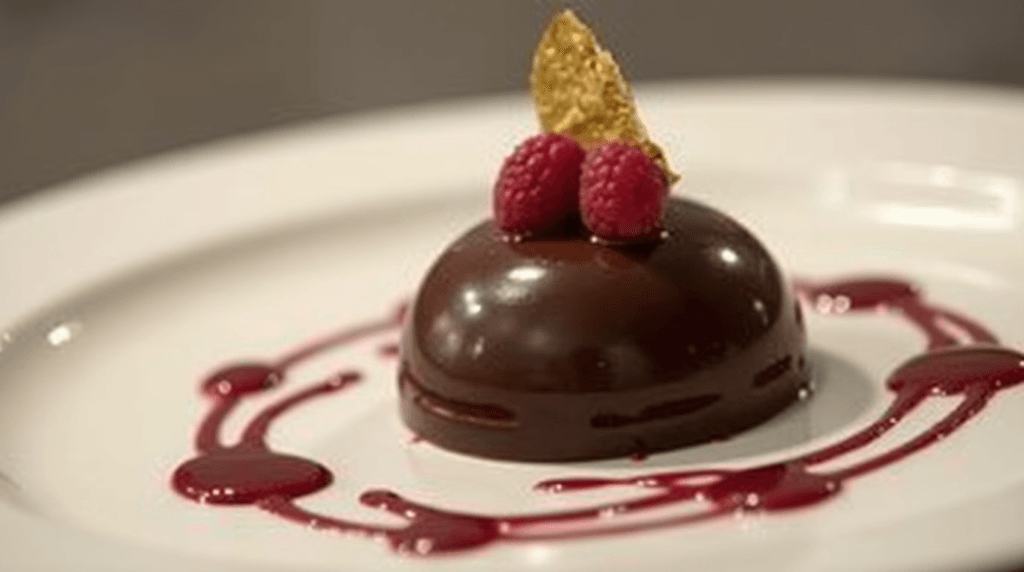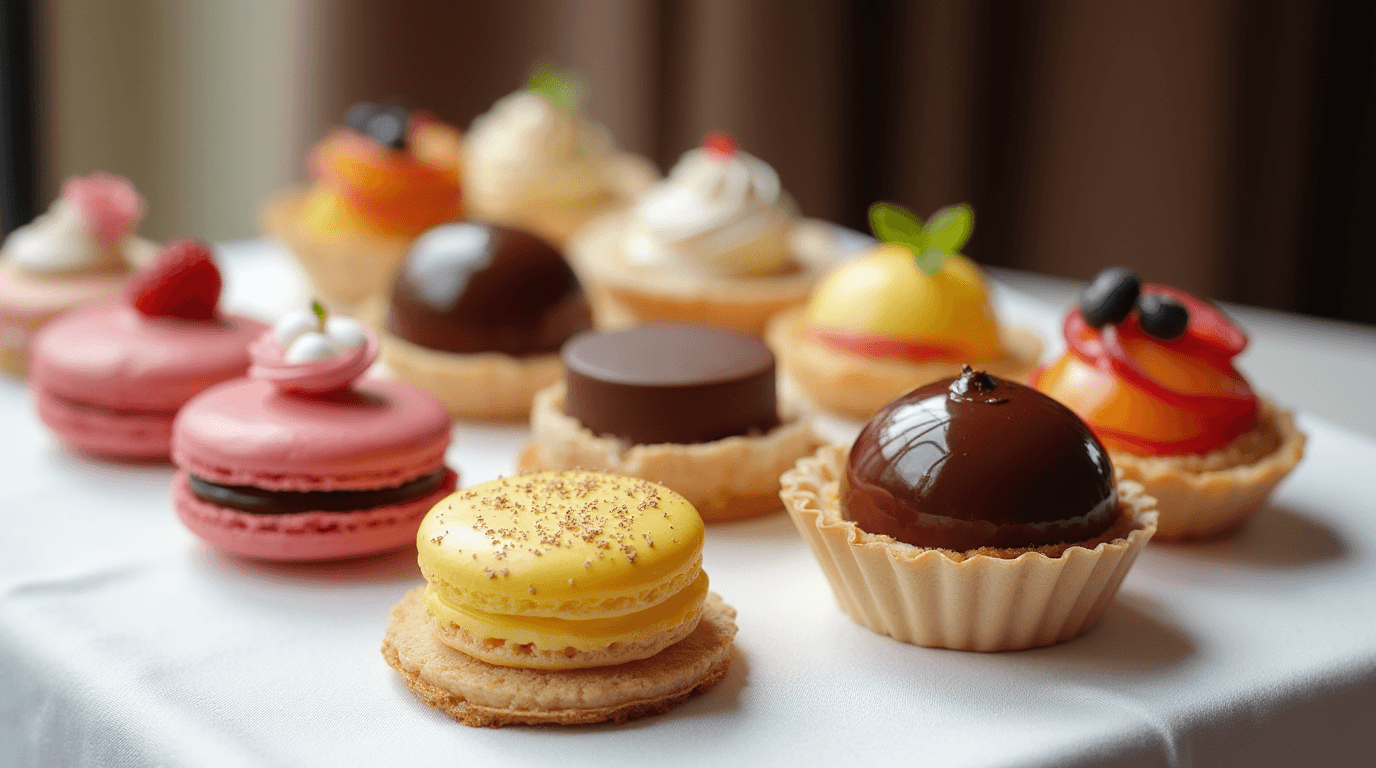Some desserts taste great, but fancy desserts? They make jaws drop.
From glossy ganache to delicate layers and stunning garnishes, these recipes are all about presentation and wow factor. Whether you’re hosting or just in the mood to show off, here’s your ticket to dessert-level elegance.
Table of contents
What Are Fancy Desserts?
The Definition of Fancy Desserts
So, what exactly is a fancy dessert? In simple terms, it’s a dessert that goes beyond basic taste to offer an elevated visual and sensory experience. Fancy desserts are crafted with precision, creativity, and often a touch of extravagance. Think of them as the haute couture of the culinary world. It’s not just about satisfying a sweet tooth; it’s about creating a masterpiece.
These desserts often feature high-end ingredients, unique flavor combinations, and intricate presentations. A simple slice of cake might taste great, but when it’s layered with mousse, topped with edible gold, and plated with precision, it becomes a fancy dessert.
“A fancy dessert is like a symphony every ingredient and element works in harmony to create a memorable experience.”
The History of Fancy Desserts
The concept of fancy desserts isn’t new. It dates back to ancient civilizations when desserts were considered a luxury for the elite. In medieval Europe, intricate marzipan sculptures and sugar-coated fruits were served at royal feasts. Later, French chefs revolutionized dessert-making by introducing pastries like éclairs, croissants, and macarons.
Fast forward to today, and fancy desserts have taken on a modern twist, incorporating science, art, and even technology. From flaming baked Alaskas to nitrogen-frozen mousses, the evolution of fancy desserts is a testament to human creativity and innovation.
Why Fancy Desserts Are So Popular
A Blend of Art and Flavor
One major reason for their popularity is the way fancy desserts seamlessly blend culinary art with incredible flavors. Let’s face it: we eat with our eyes first. A beautifully plated dessert can make your heart skip a beat even before you take the first bite. But the magic happens when those stunning visuals are backed up by complex and delightful flavors.
Imagine biting into a dessert that looks like a tiny garden, complete with chocolate “soil” and sugar-spun flowers, only to discover layers of unexpected flavors like lavender and lemon. Fancy desserts captivate both your taste buds and your imagination.
Celebratory Occasions and Luxury
Fancy desserts also have a special place in celebrations. Think weddings, anniversaries, or even upscale dinner parties these events often call for something extraordinary. Serving fancy desserts adds a layer of sophistication and indulgence. Plus, they’ve become a hallmark of luxury dining.
Ever heard of the $1,000 ice cream sundae or the gold-leaf-covered doughnut? These desserts scream opulence and exclusivity, making them an irresistible attraction for food enthusiasts and social media influencers.
Types of Fancy Desserts
French Pastries: The Epitome of Elegance
When it comes to fancy desserts, French pastries reign supreme. Classics like macarons, mille-feuilles, and éclairs showcase the finesse of French baking. Each pastry is a labor of love, requiring technical precision and artistic flair.
Take macarons, for example. These colorful, delicate almond meringue cookies filled with ganache or buttercream are as temperamental as they are beautiful. A single misstep can ruin their iconic texture, but when done right, they’re pure magic.
Modern Molecular Gastronomy Desserts
If French pastries are tradition, molecular gastronomy is innovation. These futuristic desserts use science to create unexpected textures and flavors. Think edible helium balloons, transparent gel cakes, or deconstructed tiramisus.
One popular example is the “sphere” dessert liquid flavors encased in a thin gelatin shell that bursts in your mouth. These desserts push the boundaries of what food can be, making them a favorite at upscale restaurants.
Classic Yet Fancy: Cheesecakes, Tarts, and More
Who says classic can’t be fancy? A creamy cheesecake topped with fresh berries and a drizzle of coulis can be just as stunning as any avant-garde creation. Similarly, fruit tarts with their glossy glazes and colorful fruit arrangements are a timeless crowd-pleaser.
Curious how richness compares to visual flair? Discover what truly makes a rich dessert stand out
Ingredients That Make Fancy Desserts Special
High-Quality Chocolates and Exotic Fruits
The foundation of a fancy dessert is its ingredients. You’ll often find premium chocolates, Tahitian vanilla, and exotic fruits like dragon fruit or passionfruit in these creations. These ingredients aren’t just about taste they add an element of rarity and exclusivity.
Unique Flavor Infusions and Rare Ingredients
Ever tried a lavender-infused panna cotta or a saffron-flavored crème brûlée? Fancy desserts often feature unusual flavor infusions that surprise and delight. Some even use rare ingredients like truffle oil or matcha powder to stand out.
“The secret to a fancy dessert is in the details each ingredient is chosen not just for flavor, but for the story it tells.”
Techniques Behind Creating Fancy Desserts

The Art of Plating and Presentation
Creating a fancy dessert isn’t just about the ingredients or taste it’s also about the visual appeal. Have you ever noticed how desserts in upscale restaurants look almost too good to eat? That’s because chefs invest a lot of time perfecting the art of plating.
Plating a fancy dessert is like painting a picture. Chefs use tools like tweezers for precise placement of edible flowers, gold leaf, or even micro herbs. They play with shapes, colors, and textures to create a dish that’s visually stunning. Swirls of sauces, powdered sugar accents, and elegant garnishes are just a few ways chefs take presentation to the next level.
A popular technique is the “sauce swoosh,” where a vibrant sauce is spread across the plate with a spoon for an artistic effect. Another trend is stacking components layering mousses, cakes, and crunches vertically to create a sense of height and drama.
“Plating is the moment where a chef’s creativity truly shines. It’s like turning a canvas into a masterpiece except this one is edible!”
Tools and Equipment Used by Dessert Chefs
Creating fancy desserts often requires specialized tools. Ever wondered how those perfect chocolate curls or intricate sugar sculptures come to life? Here are some tools that dessert chefs rely on:
- Silicone molds for shaping cakes, mousses, and chocolates.
- Blowtorches for caramelizing crème brûlée or creating dramatic finishes.
- Edible airbrushes for adding color gradients to desserts.
- Chocolate tempering machines for achieving that perfect glossy finish.
Even basic tools like offset spatulas, piping bags, and acetate sheets play an essential role in crafting those delicate details that make a dessert fancy.
Tips for Making Fancy Desserts at Home
Choosing the Right Ingredients
If you’re inspired to try making fancy desserts at home, start with the basics: high-quality ingredients. Good chocolate, fresh cream, and real vanilla beans can make a world of difference. Opt for seasonal fruits they not only taste better but also add a vibrant, natural touch to your creations.
Keep in mind that fancy doesn’t always mean expensive. You can elevate a simple dessert by focusing on presentation and attention to detail. For example, a basic chocolate pudding can look sophisticated when served in a martini glass with a dollop of whipped cream and a sprinkle of cocoa powder.
For more inspiration on high-impact, low-effort desserts, check out our quick & easy recipes collection.
Step-by-Step Recipe Examples
Here’s a simple yet impressive recipe you can try:
Mini Berry Pavlovas
- Ingredients: Egg whites, sugar, vanilla extract, heavy cream, fresh berries.
- Steps:
- Whip egg whites with sugar until stiff peaks form. Pipe into small circles on parchment paper and bake at 250°F for an hour.
- Once cooled, top with whipped cream and fresh berries.
- Add a drizzle of fruit coulis for an extra fancy touch.
This dessert is light, airy, and perfect for impressing guests without requiring advanced skills or tools.
“Remember, making fancy desserts at home is all about having fun. Experiment with flavors, play with textures, and don’t stress about perfection!”
Prefer something more traditional but still impressive? You’ll love our Grandma’s recipes, timeless, comforting, and crowd-pleasing.
Frequently Asked Questions (FAQs)
What makes a dessert “fancy”?
It’s all about presentation and technique. Fancy desserts often include layers, glazes, delicate garnishes, or artistic plating.
Do fancy desserts require special tools?
Not always. While tools like piping bags or ring molds help, many impressive desserts can be made with just a sharp knife and steady hands.
Can beginners make fancy desserts?
Yes, start with simple elements like chocolate drizzle, fruit toppings, or shaped cookies. Small touches can elevate a basic recipe.
What are some easy fancy desserts for parties?
Mini cheesecakes, mousse cups, layered trifles, and fruit tarts look elegant but are surprisingly easy to prepare ahead of time.

